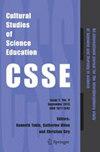明摆着的手势:可持续未来在世界上的存在和行动的对话表演
IF 1.5
4区 教育学
Q2 CULTURAL STUDIES
引用次数: 0
摘要
Gudrun Jonsdottir和Anne Kristine Byhring在科学课堂中提出了一个关于共同未来的关键问题,本文关注并扩展了对话空间的构建。它不是简单地作为一个抽象的概念来描述不同思想的存在或习语的交流,而是一个充满隐喻和物质人工制品的空间,它存在于世界上。在此基础上,科学教育重视感官对空间的感知能力,作为物理和物质的行为,源于人们的生活经验并与之密切相关。通过使赋予人类经验生命的物质关系变得可见,通过赋予不同的想象生命,科学教育因此可以成为深刻的对话:远离对同一性的期望,它本身就包含了获得作者身份和形式的邀请,这是一种叙述,一种个人旅程,或者一种看待世界的不同方式。这就是我所说的“在明处做手势”,一种批判性地与物质人工制品及其关系接触的科学教育;一个是象征和经验的领域,一个是一般意义上的可持续未来,特别是对科学教育工作的重新定位和重新思考。本文章由计算机程序翻译,如有差异,请以英文原文为准。
Gesturing in plain sight: dialogical enactments of sustainable futures as being and doing in the world
Abstract Addressing the critical question posed by Gudrun Jonsdottir and Anne Kristine Byhring who are asking what place for a common future in the science classroom, this paper focuses on and expands on the construct of dialogical space. Not simply as an abstract concept to describe the presence of divergent ideas or the exchange of idioms, but a space filled with metaphors and material artefacts that exist in the world . On this basis, science education takes seriously the affordances of sensorial perception in space, as physical and material doings , arising from and deeply concerned with the lived experiences of people. By making visible the material relations that give life to human experience, and by giving life to different imaginations, science education can thus become profoundly dialogical: turning away from the expectation of sameness, it houses in itself the invitation of taking authorship and to give form, that being a narrative, a personal journey, or a different way of looking at the world. This is what I call gesturing in plain sight, a science education that critically engages with material artefacts and their relations; one that inhabits the realm of the symbolic and the experiential, and one that speaks to sustainable futures in general, repurposing and reconceiving the work of science education in particular.
求助全文
通过发布文献求助,成功后即可免费获取论文全文。
去求助
来源期刊

Cultural Studies of Science Education
Multiple-
CiteScore
3.10
自引率
0.00%
发文量
45
期刊介绍:
Cultural Studies of Science Education is a peer reviewed journal that provides an interactive platform for researchers working in the multidisciplinary fields of cultural studies and science education. By taking a cultural approach and paying attention to theories from cultural studies, this new journal reflects the current diversity in the study of science education in a variety of contexts, including schools, museums, zoos, laboratories, parks and gardens, aquariums and community development, maintenance and restoration.
This journal
focuses on science education as a cultural, cross-age, cross-class, and cross-disciplinary phenomenon;
publishes articles that have an explicit and appropriate connection with and immersion in cultural studies;
seeks articles that have theory development as an integral aspect of the data presentation;
establishes bridges between science education and social studies of science, public understanding of science, science/technology and human values, and science and literacy;
builds new communities at the interface of currently distinct discourses;
aims to be a catalyst that forges new genres of and for scholarly dissemination;
provides an interactive dialogue that includes the editors, members of the review board, and selected international scholars;
publishes manuscripts that encompass all forms of scholarly activity;
includes research articles, essays, OP-ED, critical, comments, criticisms and letters on emerging issues of significance.
 求助内容:
求助内容: 应助结果提醒方式:
应助结果提醒方式:


